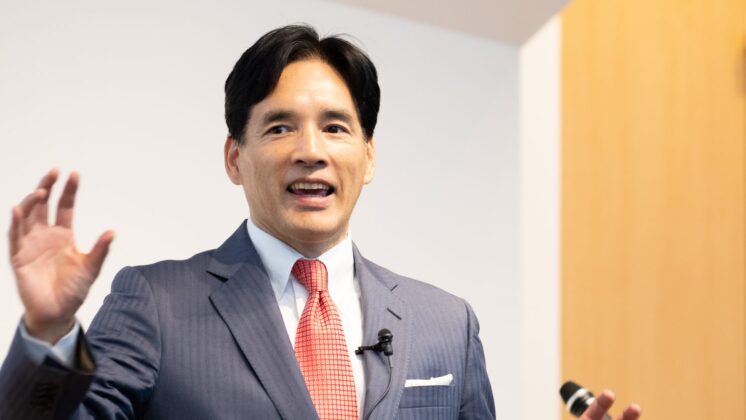When I woke up in Iwaki in the morning, small aftershocks were still continuing. Feeling a significant tremble, I switched the television on. The flash report said the jolt was 4 on the Japanese seismic scale. That wasn’t a big one, I said to myself. A local TV station reported radiation levels in various parts of Fukushima Prefecture, in addition to weather forecasts. “Today’s radiation level is 0.35 μSv per hour for Iwaki.” That level wasn’t serious, either.
My thoughts on the morning after the KIBOW Iwaki Meeting were as follows. Iwaki is a place that has produced many strong-minded individuals. I felt hopeless when I visited tsunami-stricken areas, such as the devastated fishing ports, coastal districts and deserted neighborhoods within a 20-kilometer radius of the nuclear power plants. But the people I met and spoke with at the KIBOW Iwaki Meeting gave me energy and strength. I felt those people were burning with passion.
My plan was to visit places around Iwaki, such as an evacuation center, a bicycle racetrack that is functioning as a base for distributing goods to local residents in need of help, and a urological hospital, to which Ms. Miyo had been sending supplies from Tokyo for three days. I was falling more and more in love with Iwaki.
I left for the task in my car, listening to FM Iwaki. The station reported the latest radiation levels every 30 minutes. The level for Iwaki was 0.36 μSv as of 11 a.m. Radiation at this level is no problem at all. Everyone in Iwaki was calm. I picked up Ms. Miyo in Onahama and drove to the Onahama branch of the Iwaki City Office to deliver crayons and pastels GLOBIS had purchased with Plus Corporation.
The principals of the Nagasaki and Ena elementary schools were there to meet me. Both were women. They were very friendly. I donated a pile of stationery that filled the trunk of my station wagon to their two schools. I’d like to tell Plus Corporation’s management team members and Mr. Ito of GMBA that I delivered the stationery to children.
The Nagasaki Elementary School was closed at that point due to damage from the tsunami. Children at the school were said to have attended classes at the Ena Elementary School while their school was closed. But an earthquake that occurred two days ago forced the Ena Elementary School to close as well. According to the principal of the Nagasaki Elementary School, a tsunami almost two meters high rolled in after the aftershock, and washed her car down into the hallway of a school building.
We drove to the Iwaki Taira Bicycle Racetrack by way of the Nagasaki Elementary School.
On the way, I noticed that someone replied to my tweet straightaway. “My child goes to the Nagasaki Elementary School. I’m pleased to write you,” said the reply. “My child is now attending an elementary school in Niigata Prefecture because our house is ready to collapse any time. We’re hoping to go back to Iwaki as soon as aftershocks stop. Thank you for delivering stationery to children at our schools. I support the KIBOW Project.” I wrote back immediately, saying, “I’m glad to make contributions however little they might be.” The Twitter exchange warmed my heart.
We visited the Iwaki Taira Bicycle Racetrack, which was functioning as a base for accumulating relief supplies, next. We saw mountains of water in PET bottles, retort-pouch foods, diapers, sanitary items, blankets, rice bags and secondhand clothing sent from places such as Shiga Prefecture, Gifu Prefecture and Tokyo’s Minato Ward around the Racetrack and in a basement parking lot. There were a small number of SDF members and Nippon Express Co., Ltd. employees, too. The volume of goods accumulated there appeared too large, no matter how we looked at them.
There was a garbage dump at the Bicycle Racetrack. Some of the blankets and secondhand clothing we saw were marked with an X. Probably those goods will end up in the dump. I heard that evacuation sites were being prioritized for deliveries. People said evacuation sites were being flooded with goods for this reason.
We were also initially told to bring stationery to the Iwaki City Office. But we telephoned the Nagasaki and Ena elementary schools and decided to hand over the stationery we had transported to their principals directly. What we saw at the Racetrack proved our decision was right. I believe pinpoint supply is the most effective way for individuals and groups of supporters to deliver goods to people in need.
Goods collected and sent with good intentions in an emergency were stacked up and kept away from people in need. The reality I saw gave me mixed feelings. Later, I heard workers at the Racetrack receive requests for “quick handouts” when expiration dates draw near or partially pass for rice balls and other items. I thought the practice may be a classic example of inefficiency that rises as operations move closer to the government.
We moved to the Iwaki Urological Hospital from the Racetrack. This is the hospital to which a total of 100 friends from GLOBIS, the GMBA program, and Iwaki kept sending supplies on a 4-ton truck over a three-day weekend under the leadership of Ms. Miyo. I walked into the hospital, which is located on a riverbank adorned with cherry blossoms with my heart pounding fast. There was a shikishi (large square signature card) carefully posted on a hallway wall next to the reception. It had the words, “Ganbappe (Harambee), Iwaki,” written by people in Tokyo who offered to assist in the efforts to support the hospital.
I visited Mr. Kanbara, a trustee, and Mr. Owada, a general affairs section member, at the Iwaki Urological Hospital. They were the two persons at the hospital whom Ms. Miyo contacted directly by phone through a mutual friend, a journalist based in Iwaki, in the hope of delivering goods to a “hospital that has stayed beyond the reach of administrators.” By pure chance, I witnessed the first meeting by people who had communicated with each other over the phone many times since the great earthquake.
Mr. Kanbara started off by bowing his head deeply and saying, “Thank you very much for your help in the hardest period.” Continuing, he said, “We had no water or food in those days. Nothing but water arrived from administrators during the period from the day of the earthquake (March 11) to March 18. We had survived on rice balls, which we made by cocking rice in storage, and retort-pouch food only. We thought it must be a dream when you really brought us foods in that truck.
“All people, including hospital employees, lived and slept at the hospital at that point because there was no water in our houses. We almost cried in joy when canned foods and side dishes arrived in your truck. Our women were thankful for sanitary items you delivered. We distributed them to our patients and nearby hospitals after handing them out to our employees. The driver left immediately after unloading the truck. So, we felt as if a charitable man wearing a facemask came and left in a hurry.
“We went to the Bicycle Racetrack to pick up goods after their arrival on your fully loaded 4-ton truck over the three-day weekend. Carrying goods out of the Racetrack was relatively easy at the beginning, but after a while it became necessary to make an application. Then, moving goods from the Racetrack was restricted to two days a week. Now, medical and nursing care workers are not allowed to take anything out of the depot. We have a surplus of food now because local supermarkets began offering sufficient products. But we were truly thankful for your relief supplies which arrived in the hardest period.”
The feeling of gratitude made Mr. Kanbara’s eyes well with tears.
We decided to leave after taking photos in front of the shikishi, which people who had gathered relief supplies in Tokyo had sent to the hospital. We received an armful of canned sea urchin and sweets native to Iwaki, such as Rosage and Jangara, as presents from the hospital. Seeing the two hospital officials waving hands for a goodbye until we disappeared from sight, I took a right and drove the car homeward to Tokyo.
I felt something hot surging inside of me. I was just an onlooker, but I felt truly glad, realizing that I had served other people. We ran into a long line of cars on our way back to Tokyo because of a single lane traffic rule imposed to help return depressed roads to original conditions. Further construction work would become necessary soon despite these restoration efforts when earthquakes occur as frequently as this, I thought.
Asking Ms. Miyo to take over behind the wheel, I tweeted as follows.
I’m traveling the Joban Expressway southward now. I saw restoration work on this expressway, too. Our car passed Mito just now. We are traveling close to Tsuchiura. I see Mt. Tsukuba and the orange sun on my right. Tsuchiura belongs to the same part of Japan as Iwaki and Mito where people use “ganbappe (harambee)” as a common expression. At this KIBOW Iwaki Meeting, I felt as if Iwaki, Mito and Tokyo became united as one (though it might sound an exaggeration). Harambee, Iwaki!
The KIBOW Sendai Meeting would follow this KIBOW Iwaki Meeting. We would bring the KIBOW Meeting to the green-rich city of Sendai next on the back of the KIBOW Meetings in Mito and Iwaki. We are traveling north with KIBOW. We are now making arrangements to hold the KIBOW Sendai Meeting in mid May. I’m looking forward to discussing the future of Sendai and the future of Japan with residents of Sendai and people who call Sendai their hometown at the next KIBOW Meeting.
Our KIBOW (hope) is the source of power that will shape our towns and future. My car arrived at the GLOBIS office in Nibancho a little before 7 p.m. The three of us, Mr. Hirano, Ms. Miyo, and myself, carried our baggage into the office by ourselves and brought our two-day visit to Iwaki to a close. I’d like to take this opportunity and convey my heartfelt thanks to Mr. Hirano and Ms. Miyo who helped me with their hard work.
I’d also like to thank all people I met in Iwaki from the bottom of my heart. I went to Iwaki, hoping to encourage them, but came home feeling energized by their spirit.
April 14, 2011
Yoshito Hori
Completed at my office in Nibancho after adding information and revising my own tweets



